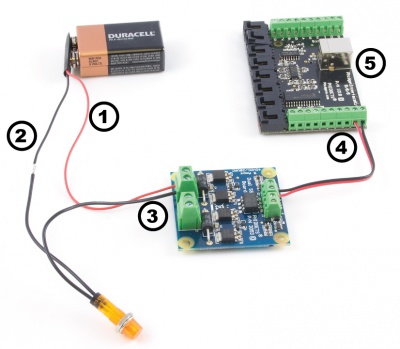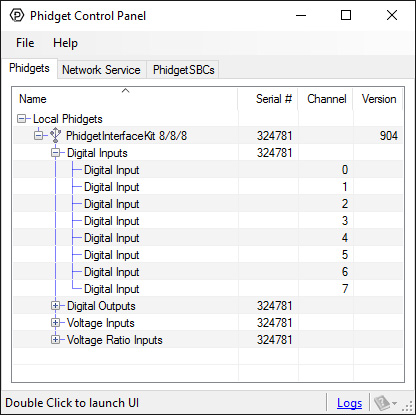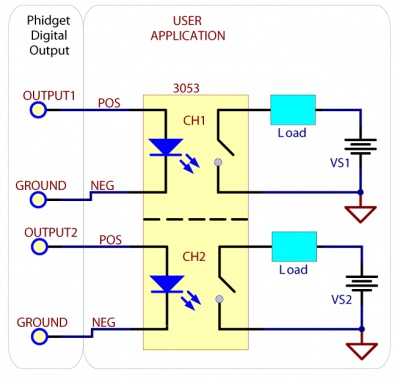3053 User Guide
Required Hardware
- A 3053 Dual SSR Phidget
- An InterfaceKit or device with a digital output
- A series electric circuit to test the relay
- Hook-up wire
- A USB Cable
- A computer
Connecting the Pieces

- Connect the circuit to one of the load terminals of the relay board.
- Attach the SSR Board to your PhidgetInterfaceKit by connecting a wire from the terminal block marked with a + to a digital output and another wire from the terminal block marked with a - to any ground terminal on the InterfaceKit.
- Connect the PhidgetInterfaceKit to your computer using a USB cable.
Testing Using Windows
Phidget Control Panel
In order to demonstrate the functionality of the 1018, the Phidget Control Panel running on a Windows machine will be used.
The Phidget Control Panel is available for use on both macOS and Windows machines.
Windows
To open the Phidget Control Panel on Windows, find the ![]() icon in the taskbar. If it is not there, open up the start menu and search for Phidget Control Panel
icon in the taskbar. If it is not there, open up the start menu and search for Phidget Control Panel
macOS
To open the Phidget Control Panel on macOS, open Finder and navigate to the Phidget Control Panel in the Applications list. Double click on the ![]() icon to bring up the Phidget Control Panel.
icon to bring up the Phidget Control Panel.
For more information, take a look at the getting started guide for your operating system:
Linux users can follow the getting started with Linux guide and continue reading here for more information about the 1018.
First Look
After plugging the 1018 into your computer and opening the Phidget Control Panel, you will see something like this:

The Phidget Control Panel will list all connected Phidgets and associated objects, as well as the following information:
- Serial number: allows you to differentiate between similar Phidgets.
- Channel: allows you to differentiate between similar objects on a Phidget.
- Version number: corresponds to the firmware version your Phidget is running. If your Phidget is listed in red, your firmware is out of date. Update the firmware by double-clicking the entry.
The Phidget Control Panel can also be used to test your device. Double-clicking on an object will open an example.
Digital Output
Double-click on a Digital Output object {{{2}}} in order to run the example: [[Image:{{{1}}}_DigitalOutput_Example.jpg|center|link=]]
General information about the selected object will be displayed at the top of the window. You can also experiment with the following functionality:
- Toggle the state of the digital output by pressing the button.
Testing Using Mac OS X
- Go to the Quick Downloads section on the Mac OS X page.
- Download and run the Phidget OS X Installer
- Click on System Preferences >> Phidgets (under Other) to activate the Preference Pane
- Make sure your device is properly attached
- Double click on your device's objects in the listing to open them. The Preference Pane and examples will function very similarly to the ones described above in the Windows section.
Testing Using Linux
For a general step-by-step guide on getting Phidgets running on Linux, see the Linux page.
Using a Remote OS
We recommend testing your Phidget on a desktop OS before moving on to remote OS. Once you've tested your Phidget, you can go to the PhidgetSBC, or iOS pages to learn how to proceed.
Technical Details
Solid State Relays
Solid State Relays, or SSRs, are devices designed to operate like standard relays but without mechanical motion. Built instead out of silicon transistors, SSRs allow currents and voltages to be switched by simple digital signals from a microprocessor or any other device that can supply the small amount of current needed to activate the SSR’s internal switching mechanism. For more information on solid state relays, refer to the SSR Primer.
Using the SSR Board
|
Using the SSR Relay Board in your application is typically done according to the diagram on the right, though there are other implementations for it as well. The SSR control inputs can be controlled with a wide range of voltage levels between 3 and 30V. Be sure to match the polarity of the control signal with the +/- labels on the input terminal blocks. One concern with any type of relay is the turn-on and turn-off times. Since the SSR Board uses optoisolation, the turn-on delay depends on how strong the control signal is, while the turn-off delay is quite constant, and quick. The 3053 uses internal circuitry to keep the current of the control signal around 10mA, no matter how what voltage level is used. To improve the turn-on time of the SSR, a short current spike (approximately 35mA for 300μs) at turn-on is possible if your control signal can provide it. This allows the SSR to turn on quicker, reducing heating during the turn-on transition. If your control signal is not able to provide the 35mA, the SSR will turn on anyway, but will take up to 50% longer. If the Phidget InterfaceKit 8/8/8 is being used to drive the input, the control signal has an output resistance of about 250 Ohms, and the SSR has a turn-on time of 1.90ms. The turn-off time is approximately 160μs. |
| |
Isolation and Protection Devices
The SSR Board is safe to use with sensitive control devices like microprocessors, and will not damage a Phidget device or your PC. This is achieved through the use of an optoisolation chip - creating a physical barrier between the SSR control inputs and the potentially high voltage and high current outputs. In addition to the optoisolation between the inputs and outputs, there is an on-board 47V voltage supression device across the relay output that protects the board from static electricity and surges from inductive loads. To protect the optoisolation LEDs from potential overcurrent on the inputs, a transistor-based current limiting circuit has been added. The circuit limits the constant current travelling through the LEDs to 10mA, regardless of the input voltage. The transistors dissipate what would have been extra current in the form of heat. The 3053 Dual SSR Board comprises of two channels. Both channels are electrically and physically isolated from each other, and are controlled individually.
Warning
The SSR Board is able to safely switch at a speed of 20Hz. This board is not intended as a high frequency switch due to the extreme heating that will occur. Although it is possible to switch the SSR Board at up to 300Hz, it easily produces enough heat to liquefy the solder underneath the transistors (which requires at least 240ºC) at a 3A load.
What to do Next
- Programming Languages - Find your preferred programming language here and learn how to write your own code with Phidgets!
- Phidget Programming Basics - Once you have set up Phidgets to work with your programming environment, we recommend you read our page on to learn the fundamentals of programming with Phidgets.

